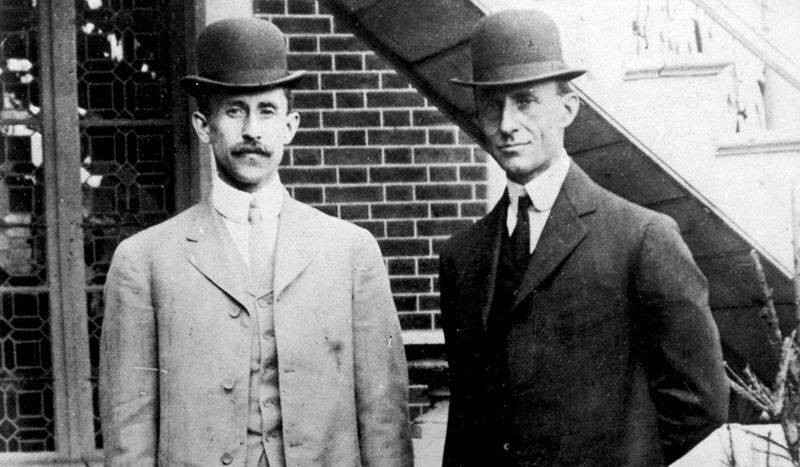Those magnificent men in their soaring machines? Early aviation in The Mechanical Engineer
Published by the Scientific Publishing Company, Manchester, between 1897 and 1917, The Mechanical Engineer is a remarkable publication. Digitised for Business, Economic and Labour History, the latest of AM’s Research Skills resources, this weekly paper provided its readers with news on the latest developments in a wide range of industries, often accompanied by detailed technical drawings, measurements, and other vital data. One can only imagine its impact upon those at the cutting edge of science, engineering and commerce (and perhaps also hobbyists, although you would need a very large shed to produce your own version of most of the machinery it showcased.)
One of the great developments of this era was the advent of powered flight, and on 2 October 1903, a couple of months before the Wright Brothers’ first successful flight at Kitty Hawk, The Mechanical Engineer reported that:
'The unfortunate deaths of Otto Lillenthal in Germany, and later of Lieutenant Pilcher in this country, while making experiments with soaring apparatus, personally guided in mid-air by the operator, put an end for some time to experiments of this kind. But the problems of aerial flight are so fascinating, and the results attained by the two unfortunate men named in many ways were so striking, that it was hardly likely that the continuance of such experiments would long remain in abeyance, and lately two Americans, Mr Gustave Whitehead, of Bridgeport, Conn., and Mr Orville Wright, of Ohio, have been working independently in this field.'
The 'soaring' of Mr Whitehead's machine, the article continues, was 'effected by means of a windlass and a hauling, and was in reality a kind of kite pulled against the wind'. Wright's 'experiments... were conducted with natural winds as the operating agent, and thus, in a way, more akin to bird flight... many of the glides were made in winds of over 20 miles an hour, and demanded on the part of the operator considerable skill and daring. The longest glide recorded was one of 662ft.' Although the terms ‘aeroplane’ (i.e., a wing which generated lift) and ‘flying machine’ had both previously been used by the paper, these devices did not qualify as what we would now call an aeroplane.

The Wright Brothers, 1908.
The Wright brothers announced the news of their successful experiment, carried out in December 1903, in January 1904; however, The Mechanical Engineer, like many other news outlets, did not mention it. Other pioneers did receive the paper's attention: the issue of 1 October 1904 announced that a Brazilian 'Señor Alvares' had designed a 'new aeroplane flying machine' fitted with 'two swing-like aeroplanes' and a two-horsepower motor driving 'two 2-bladed tractors'. Alas, it did not appear 'that the invention has any power of raising itself from the ground', and was to be launched from a balloon, 5,000 feet above the Crystal Palace in London! Meanwhile, the Wright brothers’ flights were little-known outside of their native Ohio, and often dismissed as impossible.
By February 1908, the Wrights had gained recognition. Reporting a lecture given in Glasgow by a Mr Walter A. Scoble, The Mechanical Engineer noted that the Wright brothers' work was 'traced in detail, all their machines being illustrated and the important changes mentioned. A letter was read describing the record flight by Wright of 24 miles on a power-driven aeroplane.' Some scepticism remained; Scoble was compelled to explain how it was possible for aircraft to land safely. Nevertheless, progress was being made, and a few months later, Orville Wright piloted the first flight to carry a passenger. The next year, the first air race was held in France. The idea had taken off, the only way was up, and I have succeeded in inserting two bad puns into one sentence.
The Mechanical Engineer can be explored in Business, Economic and Labour History, along with other collections including a complete run of the London Stock Exchange Year-Book for 1874-1945, the original manuscript diaries of Hugh Dalton, the Treasury papers of John Maynard Keynes, and the papers of Carl Meger and W.S. Jevons.
Recent posts

The blog highlights American Committee on Africa, module II's rich documentation of anti-apartheid activism, focusing on the National Peace Accord, global solidarity, and student-led divestment campaigns. It explores the pivotal role of universities, protests, and public education in pressuring institutions to divest from apartheid, shaping global attitudes toward social justice and reform.

This blog examines how primary sources can be used to trace the impact of young voices on society, particularly during pivotal voting reforms in the UK and the US. Explore materials that reveal insights into youth activism, intergenerational gaps, and societal perceptions, highlighting their interdisciplinary value for studying youth culture, activism, and girlhood across history.
